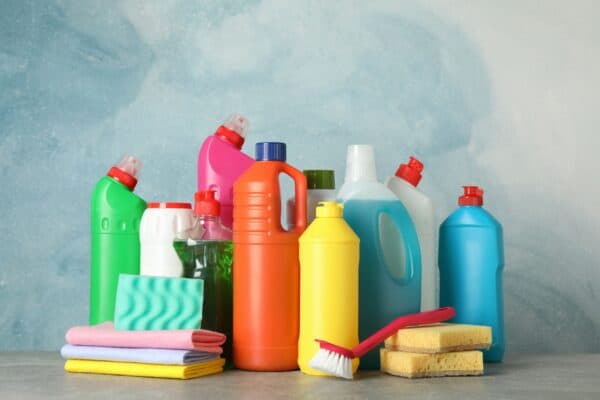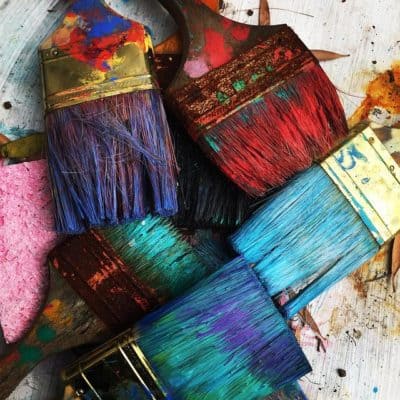Sometimes when we buy something in the supermarket, our brains automatically convert the product to “safe”, including most household chemicals. There’s no way our local grocery store would sell us something that is hazardous, or is there? The National Safety Council concludes that there were 15,111 injuries among babies and toddlers among a 100,000 population pool in 2020. Warning labels only go so far and after we see them so often we tend to get complacent to the dangers. We’ll go over some of your most common household chemicals and how to handle them.
Under the Kitchen Sink
Everyone has that treasure trove of household cleaners under their kitchen sink that is at eye level with your very smallest of humans. Therefore, it is of the utmost importance to make sure this storage space is only carefully accessed by adults. Let’s look at some contents that usually take occupancy here:
Glass Cleaner – Contains isopropanol and ammonia.

- Threat level is minimal to lethal. Can cause irritation to the skin, eyes, and throat when in contact. If swallowed can cause unconsciousness or death.
- Wear gloves when using and make sure the area is well-ventilated. Consider mixing 1 part distilled vinegar to 10 parts water in a spray bottle for a safer alternative, homemade cleaner.
Oven Cleaner – Most often contains highly concentrated Lye.
- Threat level is medium to lethal. Can cause chemical burns when in contact. If swallowed can cause tissue damage and/or death.
- Always wear safety goggles, gloves and an apron when handling this household chemical. Be careful to not breathe the fumes. Make sure the space is well-ventilated. You can also get this product without lye. Look for products that don’t contain it, if you want to minimize your risk, but be aware of what the substitution is.
Antibacterial Cleaner – Can contain pesticides quaternary ammonium or phenolic chemicals.
- Surprisingly, the threat level is not too high, but this cleaner is not to be used in excess. Using all the time can kill good bacteria and cause bad bacteria to become more resilient. If left on skin, can cause burning and irritation.
- Only use when the situation really calls for it, like when you are cleaning up after preparing raw meat or cleaning a bathroom. Wear gloves when using and be careful not to get it on your skin. If you do, wash it off immediately.
Household Chemicals In Your Basement or Garage
We might buy something to use only half of it once and store it away, possibly never to be touched again until it sees the trash. This is where these household chemicals live. You might keep the very harshest of compounds here as well.
Paint – Paint can be Latex-Based or Oil-based, Containing Different Organic Solvents.

- When latex paint is drying, it can emit formaldehyde.
- Surprisingly, the threat level is pretty low, unless you ingest large quantities of either. Both types can irritate the skin and eyes and cause nausea, dizziness, and fatigue if inhaled.
- Keep room fully ventilated when painting. Use a fan to draw air out for about 2 days.
Bleach – Contains Sodium Hypochlorite in Different Concentrations.
- The threat level can be minimal to severe, causing anywhere from skin irritations to prolonged vomiting.
- NEVER mix bleach with ANY other household cleaning product, especially ammonia. Bleach mixed with ammonia forms poisonous gas. Always use gloves and keep out of reach of children.
Insecticides, Insect Repellents, or Bait Traps
- Insecticides, Insect Repellents, and Bait Traps Usually Contain a large number of Chemicals, including boric acid and DEET.
- The threat level is usually minimal due to the protective packaging, but if in contact they can cause burning of the skin and behavioral changes such as anxiety, loss of coordination, and mental confusion.
- Follow directions closely. If using repellents that contain DEET only use on your clothes. When you go inside, take a shower and wash your clothes.
Chemicals Under Your Bathroom Sink
A lot of harsh cleaning products have and do live under our bathroom sink. Just like in the kitchen, it is important to keep access for adults only.
Mold and Mildew Remover – Commonly found chemicals are ammonium chloride and chlorine.
- The threat level is minimal to medium, causing breathing problems and burning if swallowed.
- Always use gloves when handling and wash off any excess that touches your skin.
Toilet Bowl Cleaner – Usually contains Bleach, Hydrochloric Acid, and/or Sodium Hypochlorite.
- The threat level is not too high unless you use it wrong or ingest it. Can cause serious breathing problems and skin irritation.
- NEVER mix this with any other household chemicals, since it contains bleach. Use good ventilation. Use gloves and avoid contact with skin.
We’d be remiss if we didn’t mention at least one floor-cleaning chemical!
Carpet and Upholstery Cleaner – Can contain Ammonium Hydroxide, Naphthalene, and Perchloroethylene (used in dry cleaning).
- The threat level is HIGH with this one. Fumes given off can cause disorientation, loss of appetite, sleepiness, dizziness, and nausea. These chemicals have also been linked to cause liver damage and cancer in some instances.
- Use these products in well-ventilated areas and do not breathe them in.
Please keep in mind this is not a complete list. We have just covered the tip of the iceberg of household chemicals. Check out this comprehensive list for more information. We hope this list has helped educate you on the many chemicals hanging around your house. If you’d like to keep track of these chemicals, make a safety list and post it to the inside of a cabinet door or the basement wall of the many uses and cautions. Make sure your children know what certain cleaners do and how to use them. Keep all of these chemicals and more out of reach of small children.
Healthier Floors
Our local North Cincinnati & West Chester Ohio carpet cleaning and upholstery services will also provide you and your family with a healthier living environment. Contact Olmec Reflections today and ask us about our gentle approach to extending the life of your furniture today!
